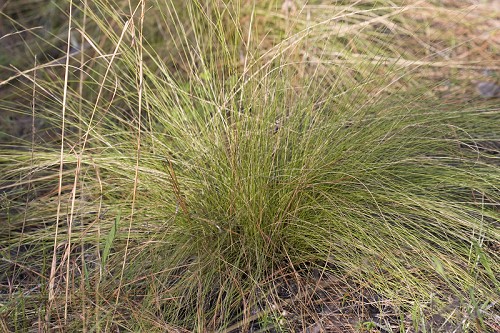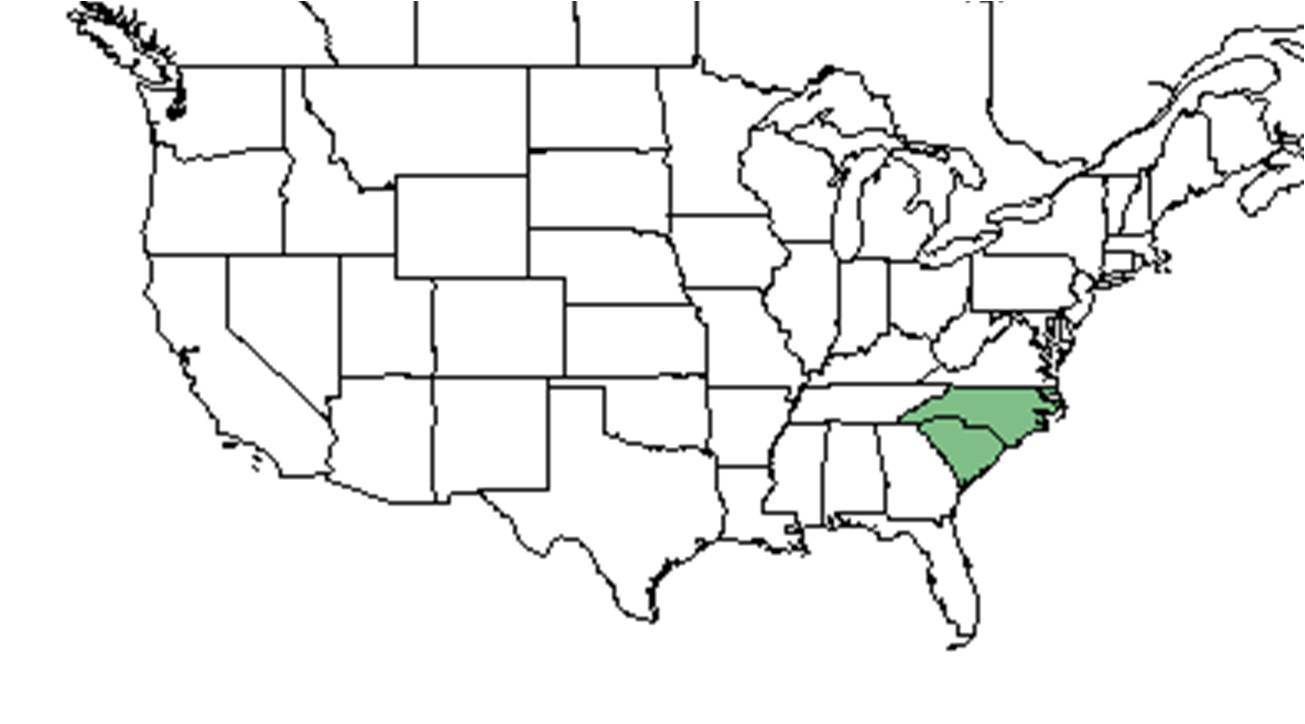Difference between revisions of "Aristida stricta"
Laurenloria (talk | contribs) (→Conservation and management) |
Laurenloria (talk | contribs) (→Description) |
||
| Line 22: | Line 22: | ||
==Description== | ==Description== | ||
<!-- Basic life history facts such as annual/perrenial, monoecious/dioecious, root morphology, seed type, etc. --> | <!-- Basic life history facts such as annual/perrenial, monoecious/dioecious, root morphology, seed type, etc. --> | ||
| − | ''A. stricta'' is a cespitose (grows in dense clumps or mats) perennial bunch grass that emerges from a clump | + | ''A. stricta'' is a cespitose (grows in dense clumps or mats) perennial bunch grass that emerges from a clump, ranging from seedlings to approximately 15 cm across at the base.<ref name= AC> Clewell, A. F. (1989). Natural History of Wiregrass (''Aristida stricta'' Michx., Gramineae). Natural Areas Journal 9: 223-233. </ref> The blades are narrow, flat, involuted, and appear to be round like wire. <ref name= AC/>Leaves are rigid yet bendable and generally 0.5m long.<ref name= AC/> The blades are narrow, flat, and involuted. <ref name= AC/> The shallow, dense wiry roots are adept at taking in nutrients. <ref name= AC/> Maintains an approximate density of five clumps per square meter. <ref name= AC/> The seeds are translucent brown, rough in texture, cylindrical like in shape but narrow at the ends, 4.5 mm in length and 0.4 mm in width. <ref name= AC/> With the correct fire pattern a population of ''A. stricta'' can survive indefinitely, possibly germinating from seeds thousands of years ago.<ref name= AC/> It is a keystone species of the Coastal Plain longleaf pine ecosystem. |
==Distribution== | ==Distribution== | ||
Revision as of 09:06, 22 November 2016
| Aristida stricta | |
|---|---|

| |
| Photo by John R. Gwaltney, Southeastern Flora.com | |
| Scientific classification | |
| Kingdom: | Plantae |
| Division: | Tracheophyta - Vascular plants |
| Class: | Lilianae - Monoctyledons |
| Order: | Poales |
| Family: | Poaceae |
| Genus: | Aristida |
| Species: | A. stricta |
| Binomial name | |
| Aristida stricta L. | |

| |
| Natural range of Aristida stricta from USDA NRCS Plants Database. | |
Common names: Threeawn, Wiregrass
Contents
Taxonomic notes
Synonyms: Aristida stricta (also see A. beyrichiana Trin. & Rupr.); A. stricta var. stricta Michx.
Description
A. stricta is a cespitose (grows in dense clumps or mats) perennial bunch grass that emerges from a clump, ranging from seedlings to approximately 15 cm across at the base.[1] The blades are narrow, flat, involuted, and appear to be round like wire. [1]Leaves are rigid yet bendable and generally 0.5m long.[1] The blades are narrow, flat, and involuted. [1] The shallow, dense wiry roots are adept at taking in nutrients. [1] Maintains an approximate density of five clumps per square meter. [1] The seeds are translucent brown, rough in texture, cylindrical like in shape but narrow at the ends, 4.5 mm in length and 0.4 mm in width. [1] With the correct fire pattern a population of A. stricta can survive indefinitely, possibly germinating from seeds thousands of years ago.[1] It is a keystone species of the Coastal Plain longleaf pine ecosystem.
Distribution
A. stricta is found in areas adjacent to the Coastal Plain, in the Piedmont areas in northeast North Carolina to northeast South Carolina. [2]
Ecology
Due to the loss of habitat A. stricta used to be the keystone species of the Coastal Plain in the Carolinas.[2] The foliage of A. stricta helps the lightning-set fires to spread and thereby maintain the habitats, pine savannas, sandhills, and pine flatwoods. [2] Although, those habitats are not common due to agriculture, pine farms, and development. [2] Fire suppression and ground (soil) disturbance has led to a rapid decline in A. stricta’s population throughout the Coastal Plain. [2] Weakley mentions Ward (2001) proposes there is varietal status for A. stricta and A. beyrichiana, see Weakley’s most recently updated guide. Wunderlin and Hansen (2011) mention that the Aristida stricta, in Florida, is var. beyrichiana. [3]
Habitat
Aristida stricta is considered a native groundcover in upland pinelands of South Georgia. [4] It is present in sand that is not fertile. [1]
Phenology
It flowers from September to November. [2] Flowers spring to fall. [3]
Seed dispersal
Aristida stricta disperses by gravity.[5]
Seed bank and germination
Requires high temperature for germination (30–35˚C). [6] Short-term seed persistence can occur in the soil. [7] The reproductive ability of A. stricta is poor. [1] Summer burning triggers effective reproduction [1]
Fire ecology
A. stricta is very flammable because of its highly fibrous leaf structure, vast amount of leaves, and duration of dead leaves which do not detach quickly. [1] A. stricta can withstand fire suppression for 20 or 40 years. [1] However, because the sexual reproduction of A. stricta relies on growing season fires, years of human fire suppression has diminished the population. [8]
Conservation and management
A. stricta has been observed to be negatively affected by disturbance. [9] [10] A. stricta has also been observed to have a strong association with agriculture history and burning frequency. [11] It has been observed to respond positively to cross chopping combined with ground rock phosphate fertilization. [12] A. stricta has lowest mortality when hexazinone (a herbicide) is used during dry times and when chopping is performed with high soil moisture. [13] Aboveground damage to clones can be healed but serious root damage commonly leads to death. [13]
Cultivation and restoration
Photo Gallery
References and notes
- ↑ 1.00 1.01 1.02 1.03 1.04 1.05 1.06 1.07 1.08 1.09 1.10 1.11 1.12 Clewell, A. F. (1989). Natural History of Wiregrass (Aristida stricta Michx., Gramineae). Natural Areas Journal 9: 223-233.
- ↑ 2.0 2.1 2.2 2.3 2.4 2.5 Weakley, Alan S. Flora of the Southern and Mid-Atlantic States: Working Draft of 21 May 2015. University of North Carolina Herbarium (NCU). PDF. 358; 360.
- ↑ 3.0 3.1 Wunderlin, Richard P. and Bruce F. Hansen. Guide to the Vascular Plants of Florida. Third edition. 2011. University Press of Florida: Gainesville/Tallahassee/Tampa/Boca Raton/Pensacola/Orlando/Miami/Jacksonville/Ft. Myers. 178. Print.
- ↑ Ostertag, T.E., and K.M. Robertson. 2007. A comparison of native versus old-field vegetation in upland pinelands managed with frequent fire, South Georgia, USA. Pages 109–120 in R.E. Masters and K.E.M. Galley (eds.). Proceedings of the 23rd Tall Timbers Fire Ecology Conference: Fire in Grassland and Shrubland Ecosystems.
- ↑ Kay Kirkman, unpublished data, 2015.
- ↑ Andreu, M. G., C. W. Hedman, et al. 2009. "Can managers bank on seed banks when restoring Pinus taeda L. plantations in Southwest Georgia?" Restoration Ecology. Vol 17. pgs 586-596.
- ↑ Coffey, K. L. and L. K. Kirkman (2006). "Seed germination strategies of species with restoration potential in a fire-maintained pine savanna." Natural Areas Journal 26: 289-299.
- ↑ Jennifer M. Fill, et al. (2012). The reproductive response of an endemic bunchgrass indicates historical timing of a keystone process. Ecosphere 3: 1-12.
- ↑ Hebb, E. A. (1971). Site preparation decreases game food plants in Florida sandhills. Journal of Wildlife Management 35: 155-162.
- ↑ Kirkman, L. K., K. L. Coffey, et al. (2004). "Ground cover recovery patterns and life-history traits: implications for restoration obstacles and opportunities in a species-rich savanna." Journal of Ecology 92(3): 409-421.
- ↑ C. W. Hedman, S. L. G., and S.E. King (2000). Vegetation composition and structure of southern coastal plain pine forests: an ecological comparison. Forest Ecology and Management 134: 233-247.
- ↑ Lewis, C. E. (1970). Responses to chopping and rock phosphate on south Florida ranges. Journal of Range Management 23: 276-282.
- ↑ 13.0 13.1 Outcalt, K. W. (1992). "Factors affecting wiregrass (Aristida stricta Michx.) cover on uncut and site prepared sandhills areas in Central Florida. Ecological Engineering 1: 245-251.